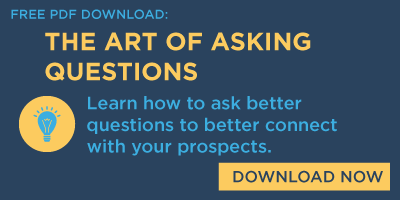 Congratulations! After all of your creative efforts to stand out, establish credibility, and demonstrate expertise, your prospect has finally agreed to meet with you. Considering how many other salespeople likely call on them in your market, this is a huge win! However, what you do next could make it all worthwhile… or simply a waste of time.
Congratulations! After all of your creative efforts to stand out, establish credibility, and demonstrate expertise, your prospect has finally agreed to meet with you. Considering how many other salespeople likely call on them in your market, this is a huge win! However, what you do next could make it all worthwhile… or simply a waste of time.
Let me demonstrate:
I’ll never forget when I accompanied a new seller on a call. This person was thrilled to have scored a meeting with a local bank that other sellers had been trying to get a meeting with for quite some time. As we leave for the call, she makes a copy of all the research she had gathered that she thought he would find useful.
15 minutes into the meeting, the prospect is not only looking at his watch – but he looks confused. Finally, he says “I thought you were going to bring me ideas on how to reach younger consumers? All of this research is fine, but I have another meeting to go to in 10 minutes.”
The sales strategy this seller didn’t do prior to the meeting: Contract and align expectations. Had she explained to him that she had planned to bring some research to review, then ask a few questions to get to know more about his business, then return with ideas based on those answers, he would have not looked so confused. He may have also allotted more time.
While it only takes a moment to do, managing expectations can make or break your entire relationship with your prospect (or anyone, for that matter!)
Here are a few things to confirm beyond the date, time and place:
- Duration – specify how much time you need. There’s nothing worse then asking for “just twenty minutes of your time” and overstaying your welcome. (Or getting asked to leave.)
- Who will attend – confirm the names and titles of everyone who will be in attendance on both their end as well as yours. Make sure you bring enough copies of handouts for everyone in attendance. Researching the roles of additional attendees on their end is also a good idea.
- Purpose – what you’re there to do. Don’t let this be a surprise to the client. Make sure they are aware and compliant with the purpose. You’ll also want to give them a heads up if you plan to ask questions they may not know off the top of their head, so they have time to find those answers.
- Non-purpose – what you’re not there to do. Just as important as the purpose. Not there to sell something? Tell them that.
- What’s in it for the prospect – state the benefits of the meeting you’re asking for. What will they leave the meeting with that makes it worth their precious time?
- Desired outcome – what do you intend to accomplish by the end of this specific meeting?
We can all agree on a personal and professional level, no one likes feeling duped into something they didn’t agree to, which is what can happen if you do not contract and align expectations. On the flipside, if you have completed the above, you’ve eliminated a great deal of stress and headache for both you and your prospect… and set the stage for a successful first meeting.
Learn how to best help your client's and prospect's
by downloading our Hourglass Needs Anaysis here



